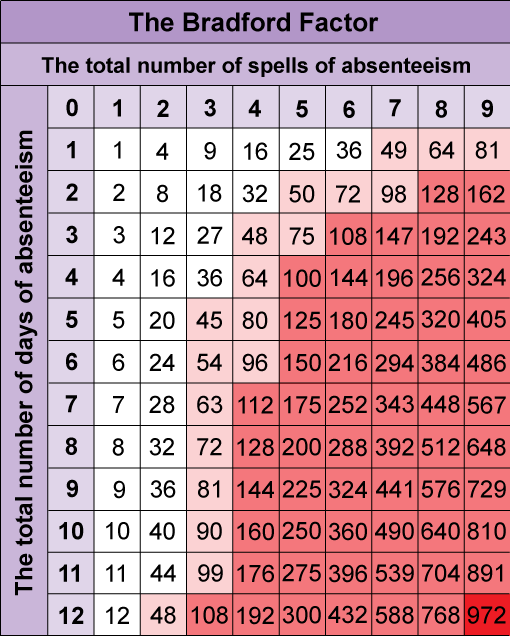7th November 2024

Absenteeism, or not showing up for work, can be a big problem for contact centres and BPOs. We all know it can hurt productivity and team spirit.
Many traditional ways of tracking absences don’t give a clear picture of individual attendance. The Bradford Factor is considered by many a better way to measure absenteeism for each employee.
The Bradford Factor is a formula that helps measure how often an employee is absent due to sickness or other reasons. It looks at both how many times someone misses work and how long they are away. This way, it can show how disruptive short absences can be.
You can calculate the Bradford Score using this formula:
Bradford Factor Score = (Number of Absences) ² × (Total Days Absent)

This means if an employee misses work often, they will get a higher score.
An acceptable Bradford Score typically falls below 45. However, various thresholds signal different actions for managers:
At this level, managers should have a casual conversation with the advisor about their attendance. It’s an opportunity to express concern and inform the employee about potential disciplinary actions if absenteeism continues.
A score above 100 warrants more formal actions. Managers may initiate processes such as monitoring attendance closely, issuing a written warning, or considering financial repercussions.
Reaching a score of 900 raises serious concerns about attendance and provides grounds for dismissal. If a manager disagrees with this assessment, a final written warning should be issued. Should attendance fail to improve post-warning, dismissal may become inevitable.
| Action | Colour |
|---|---|
| No Concern | White |
| Show Your Concern | Light Red |
| Consider Disciplinary | Red |
| Consider Dismissal | Bright Red |
The table above outlines the colour scales used for the Bradford Factor, and an example can be seen in the image below.

Bradford Factor Score = (Number of Absences)² × (Total Days Absent) = (2)² × (6) = 4 × 6 = 24
Bradford Factor Score = (Number of Absences)² × (Total Days Absent) = (6)² × (6) = 36 × 6 = 216
This example shows how the Bradford Factor highlights the impact of absence patterns, making it clear that Employee B’s frequent short absences are more disruptive than Employee A’s longer absence.
One of the primary benefits of the Bradford Factor is its ability to differentiate between types of absenteeism.
Here are some key reasons why the Bradford Factor is often considered more useful than other absenteeism measurement methods:
The Bradford Factor penalizes frequent short-term absences more heavily, reflecting the disruptive nature of such patterns. This allows managers in centres and BPOs to address attendance issues that might otherwise go unnoticed.
The Bradford Factor provides specific thresholds that trigger managerial actions. This clarity helps HR professionals and managers know when to engage with employees regarding attendance issues, streamlining the process of addressing absenteeism.
By distinguishing between long-term medical leaves and frequent short-term absences, the Bradford Factor protects employees who may have legitimate health issues, ensuring they are not unfairly penalized.
The Bradford Factor is a useful tool for keeping track of absenteeism, but it should be used carefully. The scoring system doesn’t consider disabilities or ongoing health issues, which need special attention.
Managers should make sure to note these situations, including cases of sickness, so that employees who really have health problems are treated fairly and aren’t punished too harshly for their absences.
For more tips on dealing with absenteeism in your contact centre, read our articles:
Reviewed by: Xander Freeman